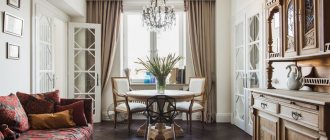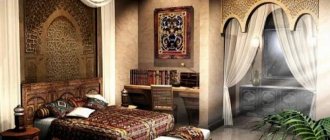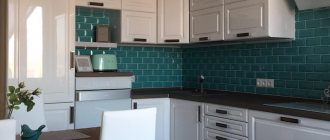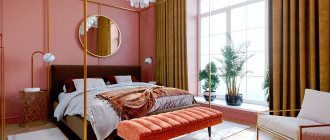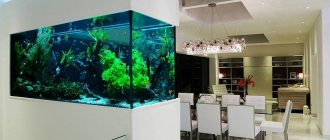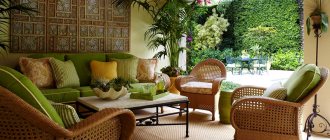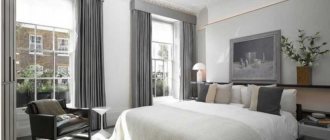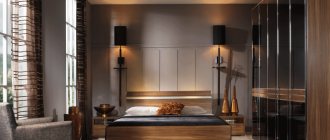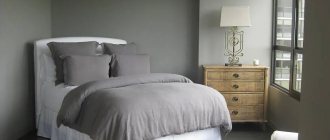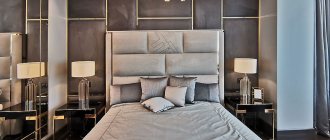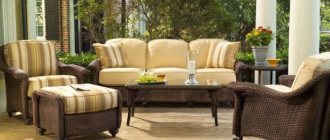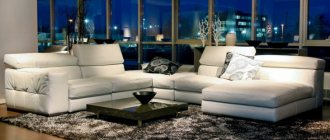Home Articles Furniture in the Stalinist style
The Stalin Empire style is a unique interior design style that emerged on the territory of the USSR during the reign of the well-known political leader I.V. Stalin. It was not some kind of new revolutionary discovery, but simply combined elements of classical, baroque, and also some art deco details. Furniture in the Stalinist style also combined their characteristic traditions, expressed in grandeur, luxury and monumentality. For many years it has been relevant and fashionable, since in general an interior decorated with such items turns out to be very cozy, harmonious and at the same time majestic.
A classic Stalinist-style apartment usually had up to five spacious rooms with high ceilings and large windows. The design of the apartments featured stucco, ceiling cornices and herringbone floors. In such a room one could often find red carpets, heavy curtains with tiebacks, crystal chandeliers with rosettes and tall grandfather clocks.
What colors are typical for the style?
The imperial style in interior design involves the use of a rather limited range of colors and shades.
The interior should contain shades of noble metals - gold, silver, bronze. They emphasize imperial luxury and create a special impression of the furnishings in the premises. In addition to the dominant tones, there are background tones that allow you to elegantly frame the radiance of gold or the coldness of silver. Among them the following can be distinguished. White. Pure noble tone, providing the heavy Empire style with a feeling of lightness and free space. The combination of white and gold colors is most often found in ceiling decoration, wall decoration and staircase design.
The main range of shades is quite laconic. This is largely due to the fact that the Empire style was initially built on the idea of patriotism and imperial triumph. The 3 colors that make up the French flag were taken as a basis: white, blue, red. Later, there were more color options. Today, even pastel colors are found in interiors, making the space more comfortable to live in.
Empire style features
Empire style is an artificially created style. It inherited the features of several great civilizations. First of all, it reflected the cultural views of Ancient Greece, Rome, and Egypt.
The name of the style can also be translated from Latin. In this case it will sound like “power”. This is precisely the main meaning of the ancient movement in art and design.
In Russia, at the time of the birth of the Empire style, it was considered good manners to imitate French culture. Therefore, the emerging trends in the design of interiors, furniture and accessories were immediately adopted by the elite of Russian society. Thanks to this, the style was divided into two types. Furniture appeared in the Russian Empire style, as well as the French direction. The first version had more softness and simplicity. France preferred pretentious pathos and luxury.
Kinds
Features of combining beds with a carriage frame with interior styles
Since the birthplace of the Empire style is France, its further development came from there. In Russia it was fashionable to do everything in the French style, so the trend quickly took over the state and royal chambers. However, here the Empire style in furniture is not traced “in its pure form”, but undergoes some changes that were justified by the taste of the Russian nobility. Nowadays it is customary to distinguish 2 main directions: French and Russian. The main differences between them: pathos and luxury in the original version, more simplicity and softness in the second. In addition, its development during the reign of Stalin can be separately highlighted.
French
Since the Empire style is characterized by a clear connection with Napoleon, his power was reflected in the appearance of the furniture. It is pretentious, pretentious, with a lot of decoration, exaggeratedly luxurious, even theatrical. The desire for power is reflected in numerous motifs decorating the furniture, where a military theme is clearly visible: peaks, swords, laurel wreaths. Many of the structures have an engraving of the letter N. All pieces of furniture were carefully arranged symmetrically, in pairs.
Russian Empire style
A separate trend is the Russian Empire style, which, unlike the French, has lost some of its “lush” forms and has become more restrained. The materials have changed: in addition to mahogany, painted birch began to be used here, as well as embroidery, which added home comfort to the atmosphere. At the same time, ancient forms and ancient Roman elements were preserved.
This difference was explained by the existing imperial ban on the import of French goods into the territory, including furniture. Therefore, there were no original copies, but only sketches and drawings, on the basis of which new headsets were created.
Conventionally, one more direction is distinguished, nicknamed the “folk” Empire style, where certain features of the style popular in capitals and rich houses were manifested. It is characterized by cheaper materials, and the gilt overlays were often made from dyed papier-mâché.
Russian Empire furniture was quite multifaceted; its appearance greatly depended on the wealth of its owner. For example, the interior of the palace chambers was furnished with items made from the most expensive materials and types of wood with a beautiful, rich finish. Landowner furniture was made according to palace samples, but from more affordable materials
In addition, the personal preferences of household members were taken into account, which left its mark on the final version
Stalinsky
The Stalinist Empire style is a special direction, different from the classical version. It contained several ideas at once, in particular, ancient Roman art and the cultural development of the USSR. As a result, the Stalinist interior is distinguished by its severity, massiveness and dimensions of objects that are easily combined with stucco molding, crystal chandeliers, velvet trim, and carved details. A certain palette was used: green, brown, beige, black. Furniture in the “Stalinist Empire” style gained the greatest popularity in the 30-50s of the twentieth century.
It is quite easy to reproduce the Empire style in a modern interior, and this direction is enviably popular. But now they are trying to tone down the pretentious look somewhat and make it more homely. To do this, choose spacious rooms with high ceilings, where fairly massive pieces of furniture will not be piled up. Mandatory elements are mirrors and numerous pillows. The materials used for production are expensive: walnut, mahogany, brocade, velvet, silk for finishing. The wood is usually solid, decorated with elegant handles and gilded elements.
Characteristic features of the style
A standard “Stalinka” apartment consists of three to five, less often two or six to seven separate rooms, a kitchen with an area of seven to fifteen square meters, a huge living room, and a spacious hallway. One-room apartments were built extremely rarely, and in three-ruble apartments two rooms were sometimes adjacent. All rooms have ceilings more than three meters high, vertically elongated windows facing one or two sides, and in some places there are bay windows. Typically, such housing is located in the “historical” center of a large city - the view from the windows is appropriate.
Apartment design from the time of Stalin combined individual features of Baroque and Napoleonic Empire, neo-Gothic and Art Deco, classicism and modernity. The thick walls of houses of this era were made of red or white brick and other non-combustible materials, and the buildings themselves had at least two floors, an abundance of stucco, and real columns. The doors here are also quite high, often double-leaf, the walls are decorated with profile cornices, and the wide “front” stairs are decorated with carpet runners.
In another way, “Stalin” buildings were called “full-size apartments” or “full-size in houses of the 50s.” Not only residential buildings, but also theaters, departmental buildings, metro stations, sports facilities, and universities were decorated luxuriously and on a grand scale. City buildings were grouped into entire ensembles; the architects of that time tried to use all the achievements of construction and fine art. The principle “the more the better”, gigantomania and optimism were in effect everywhere.
Empire style in the interior
Sideboard for dishes in the living room: a stylish and comfortable element of the interior
Imperial design is embodied only in spacious rooms. It is used to decorate high-class hotel rooms, country houses, villas, and large apartments. Empire style features:
- the room is decorated in white, beige tones, gold, purple, and blue are used for accents;
- furniture and decoration require natural, expensive materials - wood, crystal, marble, silver, bronze;
- the walls are decorated with expensive fabrics (silk, brocade), frescoes, cornices, bas-reliefs, pilasters, columns;
- the ceiling is white or cream in color, complemented by stucco with gilding and cornices;
- there is parquet with a complex pattern on the floor;
- Military heraldry, vases, bronze watches, mirrors, family portraits, paintings in gilded frames are used as decoration.
Empire style living room
The royal apartments are decorated in snow-white and cream tones. The living room is decorated with columns with voluminous stucco, decorated with gilding. Venetian plaster, luxurious wallpaper, and paintings are used on the walls between the pilasters. The ceiling is designed to match the walls, complemented by wide carved cornices, possibly frescoes. A fireplace decorated with stucco and forged grate is appropriate in the interior. Furniture includes soft furnishings, armchairs, a display cabinet, and a coffee table.
The Empire style sofa has a vintage back and armrests. Furniture upholstery is made of brocade or velvet. The dark color scheme of sofas and armchairs (red, blue, purple, brown) allows them to stand out against the background of light walls. The main lighting in the living room is created by a large crystal chandelier with pendants. Silk draped compositions on the windows are selected to match the color of the furniture. The living room is decorated with a grandfather clock, vases, paintings on the walls, and sconces with fabric lampshades.
Empire style kitchen
The basis of the imperial design in the dining area is set by expensive materials - marble floors, luxurious ceramic tiles, white ceiling with stucco. Empire kitchens are equipped with furniture made of noble wood, located along one or two walls. Cabinet furniture contains pilasters, cornices, and balustrades. Modern appliances are built into cabinets and do not stand out. The dining area is equipped with a round or oval table with decorative supports and soft chairs on curved legs with high backs. A voluminous, sparkling crystal chandelier decorates the kitchen.
Empire bedroom
It’s easy to recreate the spirit of imperial classicism in the rest room. Empire style in the interior of a bedroom involves the use of rich textiles; inserts on the walls made of expensive fabrics, tapestries, carpets with ornaments, canopies over the bed, and rich draped curtains are relevant. The main element in an Empire apartment is the bed. It should be massive, with an elegant figured headboard, velvet upholstery, carved frames and curved legs.
The vanity features vintage bases, gold plated hardware and a large mirror with a carved frame. Bedside tables, floor vases, crystal sconces and a chandelier are selected in a chic way to support the expensive imperial style. It is relevant to use a luxurious couch with curved armrests and satin upholstery in the bedroom. The image of the royal room is complemented by bronze candlesticks, figurines, a painting in a wide frame, and carved boxes.
Bedroom and children's room
To furnish the bedrooms, a standard set of furniture was used:
- Large double bed;
- Bedside tables on both sides of the bed;
- Small lamps for reading before bed;
- Trellis with dressing table function;
- Wardrobe;
- Large chest of drawers made of natural wood.
A feature of Stalin's apartments was the abundance of built-in mezzanines and closets scattered throughout the apartment. Passage rooms were often included in the layout, and sometimes separate entrances to the bathroom were provided. Children's decoration was not given much importance. The furnishings consisted of domestically produced lockers and beds.
Antique clocks with a striking mechanism, plaster figurines, candlesticks, paintings, vases and silverware were used as accessories.
Imperial decor: richness and sophistication
TV walls in a modern style: choosing the best model for the interior
No less important element than furniture and decoration is decor. It is this that gives the interior a finished and holistic look. Decorative elements should also correspond to the imperial style and be luxurious and splendid. It can be:
- marble, silver or gilded boxes and candlesticks;
- mirrors in massive bronze or gilded frames;
- fine porcelain tableware;
- watches made of wood or bronze;
- paintings in gilded frames;
- vases made of expensive materials;
- antique figurines.
The paintings may depict battle scenes or important historical events.
Massive crystal chandeliers and sconces with bronze candelabra and imitation candles are ideal lamps for Empire style interiors. Empire style in the living room interior
The windows in such rooms are decorated with forged cornices, curtains made of light fabrics and multi-layered heavy curtains with draperies, wide folds, lambrequins, tassels and fringe. The current color is purple curtains with gold trim, which matches the imperial shades.
The solemnity and pomp of the Empire style make it appropriate in interiors that should look respectable: residences of politicians, offices of bank management and reputable companies, luxury hotels.
Interior design in Empire style - video
+ Similar styles:
- › Baroque style in the interior
- › Interior in Versailles style
- › Rococo in the interior
- › Renaissance style in the interior
Antique furniture
In the photo: Antique furniture is often used in Stalin-style interiors
Antique furniture looks great in any interior. And furniture from the Stalin era is almost universal. An antique sideboard made of dark wood will well complement the design of a bright kitchen-living room, even made in a modern style. A bookcase from the times of Stalin will add zest to the office. The interior, which contains antique furniture, looks interesting and memorable. Antiques make a space more personal. But be careful when filling your interior with antique furniture. After all, if you overdo it with antique items, you can simply clutter the space. This can happen if you use too many small pieces of furniture. After purchasing a new antique table, replace it with a modern shelf by the bed. Furniture can “move” around the apartment and change its purpose. Don't be afraid to rearrange the furniture, this way you can easily change the interior. Plan the arrangement of large antique items, such as a sideboard, buffet or bookcase, in advance. During the Soviet period, “professorial” apartments were furnished with pre-revolutionary furniture sets, which smoothly transitioned into the style of that time.
What it is?
The Empire style in interior design began to be used during the imperial rule of Napoleon Bonaparte in France. Initially, the style originated from classicism, adopting its main features, but later acquired its own characteristics and characteristics. The word empire itself means “empire”. This interior style is truly famous for its scale, luxury, and pomp.
In Russia, the empire style came into fashion after the War of 1812, but remained at the peak of popularity for a relatively short time, about 30 years. It is interesting that it was during this period of history that it was divided into Moscow and St. Petersburg. The first option is most often perceived as an example of the Russian imperial style, rather cold, with strict lines and special pomp. Speaking about the modern Empire style, most often we can consider its St. Petersburg traditions, in which scale and luxury are mixed with elements of late classicism. In Soviet times, in the 30-50s of the 20th century, the so-called Stalinist version of this style came into fashion.
The main characteristic of the Empire style in interior design and architecture looks like a mixture of the aesthetics of the Roman Empire, Ancient Greece and Egypt. The decor actively uses such decorative elements as columns, pilasters, porticos, bas-reliefs, stucco moldings, mixed with military-themed wall decorations - shields, coats of arms, armor, blades.
Among the characteristic features of the Empire style are the following.
- Symmetrical elements in the design of space. Paired items are used here both in decor and furnishings.
- Sophistication and consistency in a single stylistic solution.
- Ceremony, solemnity. The living room, bedroom, kitchen look as if they are ready to receive the most distinguished guests.
- Monumentality. In such a space it is impossible to make an easy rearrangement. Every detail is carefully planned from the very beginning to take its place.
- Wealth of decorative decoration. The decoration of the premises contains many details that create a special chic characteristic of the Empire style.
- A harmonious interweaving of elements characteristic of antiquity and Ancient Egypt.
- Massive, solid furniture. Preference is given to wood of red or dark tones, richly decorated with carvings.
- Centric composition structure. Decor is used on the floor and ceiling, allowing you to correctly place accents. This could be stucco, an original ornament in the laying of parquet. Furniture is also placed according to a centric or radial principle, depending on the purpose of the room.
- Large format mirrors and paintings in massive frames. The baguette must be decorated with gilding and carved.
- Heavy and dense draperies, canopies, curtains. Bows, tassels, and other elements are used for decoration.
Imperial pomp requires space. The Empire style is best harmonized with architectural elements that correspond to its scale. Large window openings, high multi-tiered ceilings, double-leaf doors, podiums - these are what are simply necessary for the full-scale implementation of projects.
When embodying the Empire style in a modern interior, it is not at all necessary to adhere to the historical accuracy of the setting. Instead of antique items, you can use modern ones, but made taking into account the basic canons. Paintings, statues, gilded elements must correspond to imperial luxury. The designer can only achieve a visual recreation of the chosen style in French, Moscow, St. Petersburg traditions or in the spirit of the Stalinist Empire style.
French Empire
Upholstered furniture in the Empire style, tables, cabinets and cabinets of the French style had an emphasized pathos. Symmetry, clear lines, elaborate, heavy decoration were characteristic of this direction.
The French Empire style uses various motifs for decoration. Most often this is a military theme. For example, peaks, swords, torches, laurel wreaths. Pyramids and trophies could also be depicted. Some pieces of furniture were engraved with the letter N. It symbolized the power of Napoleon, glorifying the great emperor and conqueror.
Chests of drawers were almost completely replaced by low cabinets and counters with two doors. Their top cover had a marble slab that served as a console. The furniture was decorated with high mirrors. The secretaries became completely closed.
Empire style interior design
Designers are able to harmoniously fit the Empire style into the interior of an apartment thanks to modern materials and stylized objects.
Chic bedroom interior in Empire style
Empire style furniture
In the 19th century, the emphasis was on beauty rather than functionality, which is why Empire style furniture is distinguished by massive shapes, regular lines and intricate decoration.
Empire style interior details
When choosing, pay attention to the appearance of the items: all products should look as if they are worthy only of an emperor. Empire style furniture is made of wood, and expensive natural fabrics are used for upholstery.
Bronze or gilding plates are used as decorative finishing. The products are allowed to have neat carving and patination.
Modern Empire style in the interior of the apartment
Upholstered furniture in the Empire style is squat, with low carved legs and decorative armrests. At that time, narrow cabinets and cupboards with glass doors for storing dishes were very popular. Furniture was often decorated with military symbols, figures of griffins and sphinxes, and copies of architectural elements.
Atmospheric bedroom interiors in Empire style
Empire style decor
Interior design in the Empire style cannot be considered complete without decor. Moreover, the decorative component includes not only accessories, but also gilded trim, frescoes, bas-reliefs, statues of fantastic animals and busts of famous personalities.
The beauty of interior items in the Empire style
Of course, it is difficult to fit such a large-scale decor into a modern apartment, but there are items that can transform the interior and make it complete. A distinctive feature of the Empire style is the abundance of mirrors in expensive frames. They not only create an intricate play of light, but also visually expand the room, making the interior even more majestic.
Empire style in the interior can be very elegant
In addition to mirrors, for decoration you can choose bronze items (boxes, candelabra, watches), paintings with military or historical scenes, antique vases and figurines, porcelain sets. Textiles are used only to create multi-layered design of window openings.
Furniture and decor items in the Empire style
Having carefully worked out all the details of the future design, you will be able to reproduce the Empire style in the interior of a modern apartment.
Elements of Stalinist decor, accessories
The decorative elements of the Stalinist Empire style are very original - five-pointed stars, a hammer and sickle, images of ears of wheat tied with a ribbon, laurel wreaths. These are voluminous plaster or carved panels depicting ordinary working people, enthusiastically working for the benefit of a great country. On shelves, tables, and other prominent places there are bronze, wooden, porcelain figurines or sculptural groups of ideological orientation. There are also bas-reliefs with lions, as well as inlays with paintings of socially significant events.
Finish options
It is necessary to strictly follow certain rules when finishing. Whether it is a country mansion or the interior of an apartment, a city house, a cottage - the main design recommendations will be the same. Preference should be given to natural materials. The quality requirements are really high. An interior door made of solid pine would be out of place here, but an oak door decorated with carvings is quite consistent with imperial trends. In addition to valuable types of wood, the Empire style welcomes the use of marble, travertine, and other types of natural stone. Gilding, bronze, silver, and crystal are widely used in the decoration of protruding elements.
Stan
The classic version of wall upholstery for the Empire style is the use of luxurious fabrics - brocade, silk. Current trends offer more affordable solutions. Textile or textured wallpaper that imitates the interweaving of threads will harmoniously fit into the design.
You can achieve a reliable transfer of the Empire style in the interior using the following techniques.
Thoroughly plaster the walls, then cover them with matte paint. Suitable shades are white, beige, sand, olive, soft peach. Select individual zones on the wall surface with protruding elements
It is important to observe the principles of symmetry. Overhead half-columns and stucco molding are suitable for zoning. Decorate each area using wall paintings or stencils. Place mirrors that visually expand the space. Paint all protruding elements gold
Stucco molding, borders, frames should be sophisticated and elegant.
Wall surfaces in the Empire style can be decorated with paintings in carved, richly decorated frames. It is also acceptable to use photographs - ceremonial portraits in the spirit of the era, stylized as antique. You can print them on tapestries to get rid of the excessive modernity of the design solution.
Paula
It is not customary to completely hide floor coverings in an Empire style interior under carpets. They themselves are of great value and are a complete work of art. Most often, the floor is decorated with expensive parquet with a complex mosaic pattern. Natural stone tiles and marble are also considered appropriate. When creating Empire style floors, monochromatic decor should be avoided. In such interiors, artistic parquet is used, which allows the formation of complex patterns on the surface.
Ceiling
The decoration of the ceiling in the Empire style implies conciseness and rigor in the choice of colors. The most commonly used traditional coloring is white and ivory. Empire style requires a large area of ceilings and wall heights. The following techniques are traditionally used in finishing:
- painting with matte compounds;
- applying applied stucco molding;
- zoning with allocation of the central area;
- the use of large chandeliers and other lighting fixtures;
- multi-tiered.
The Empire style ceiling is one of the foundations of the style and determines the pomp and solemnity of the atmosphere. It is customary to decorate it richly and pompously, adding rosettes and other architectural details.
What materials to use when decorating rooms
Finishing materials are used exclusively natural:
- stone – mainly granite, marble;
- wood - oak, pine, spruce, cherry, hornbeam, walnut, Karelian birch, etc.;
- metals - bronze, brass, steel, silver, etc.;
- crystal;
- ceramics;
- gypsum.
The floors are usually laid out with parquet, arranged in a herringbone pattern, but not common for the entire apartment, but for each room separately. The walls are decorated with stucco panels, half-columns, plaster brackets, caissons, corner details, textured niches, etc. The ceiling must have a stucco rosette for a chandelier, the same intricate ceiling cornices, and other similar decorations. The doors are made of wood, plywood, have panels, handles painted with gold paint, and platbands with 3D carvings. They match the color of the floor covering or are painted with white oil paint.
The floors in the bathroom and kitchen are laid out with ceramic tiles, less often - with natural stone, mainly red-brown colors, and the walls - with light tiles, richly decorated with plant patterns; a narrow contrasting border is allowed.
Finishing walls, floors and ceilings
When choosing finishing materials for the Stalinist Empire style today, of course, one must also reject all synthetic solutions. Paper wallpaper turns out to be quite appropriate. Please note: they are not always light in color; they often use burgundy, pure brown or coffee tones. An ornament (for example, a stripe) is allowed, but excessive brightness is contraindicated; floors and ceilings are covered exclusively with wood.
Also used in decoration:
- bronze;
- brass;
- marble;
- granite;
- ceramics.
Color spectrum
In terms of color, the Stalinist Empire style is harsh and strict. Brown, black, beige and green tones will be absolutely dominant.
It is recommended to decorate the walls in pastel colors. Interior doors, along with the white main part, always contain multi-colored glazing.
You can also take a closer look at the combinations:
- emerald and brick;
- mustard and iron gray;
- dandelion and opal green;
- linen and mahogany tones.
Lighting
Ordinary lamps will not look harmonious in such an environment.
These are multi-arm products with shades made of bronze or its imitation. They tried to hang chandeliers with cut crystal pendants
Mostly vintage lamps with green lampshades are placed on tables and other furniture (other colors are less authentic); sconces are more varied, but when selecting them you should be careful not to go beyond the style
Accessories
The most important elements of the furnishings in the spirit of the Stalinist Empire style were plaster rosettes. A good addition to the interior can be:
- themed porcelain;
- mechanical watches;
- figurines made of plaster and copper;
- candlesticks;
- paintings and photographs “from the past”;
- tablecloths and napkins;
- mirrors in luxurious frames.
Features of the color palette
The colors of the interiors of the first half of the 20th century are very modest, practically devoid of bright colors. The furniture chosen is predominantly dark, the walls are pastel shades, the carpets are red-brown, the doors between rooms are white, with multi-colored glazing.
The most suitable color combinations:
- linen with mahogany;
- agate gray with terracotta;
- marsh with woody orange;
- antique azure with beige-red;
- lavender with dark brass;
- pale gold with chocolate brown;
- bluish-green with beaver;
- protective blue with light chestnut;
- mustard with iron gray;
- emerald with brick;
- brown-orange with khaki;
- coral with cream;
- creamy yellow with violet-black;
- dandelion with opal green;
- ocher with silver-pink.
Empire style ornament
So, the Empire ornament works for the main social task - the assertion of the power of the empire. For this reason, the solemn pomp and static power of the Empire style is unshakable, strictly symmetrical, orderly and programmatic.
In Empire ornaments there is a clear design, all elements fit into geometric shapes, circles and squares, the number of plant elements, compared to classicism, is reduced. A perfectly symmetrical composition (very often a stripe placed vertically) is created in accordance with strict rhythm and order, it breathes unshakable static, military order and does not allow any thought that this order may ever be disrupted.
Features of modern furniture
By choosing the right furniture for your living room in the Empire style, you can achieve a stunning effect. Antique luxury can be combined with modern design. At the same time, the interior turns out to be original, interesting and exciting.
Chairs in this style have low backs. Their shape is curved and their dimensions are impressive. The upholstery is made of genuine leather or expensive fabric. Couches and sofas are also covered with brocade, velvet or silk. Their backs are also low, but the seat is quite spacious. The frame is made of bronze or wood. The legs are decorated with various ornaments and antique images. Small pillows matching the color of the upholstery complete the composition.
The cabinets are of impressive size. They are created from heavy solid wood. Decorated with mirrors, gilding and elegant handles. The table can have a rectangular or round shape. The legs must have beautiful curves or antique figures. The beds are large in size and have a beautiful headboard. Sometimes canopies are used.
Having considered the features of furniture created in the Empire style, everyone will be able to create a luxurious, unusual interior in an apartment or private house.
How to choose for different rooms
Empire furniture requires a spacious room; with modest dimensions, it is advisable to decorate the house in a different style
For a living room where you plan to receive guests, it is very important to maintain splendor; this can be achieved thanks to massive furniture with luxurious decor, finishing that emphasizes pomp and idleness. In the 19th century, beauty was a priority, so you can see that imperial-style furniture is distinguished by ornate decor and regular lines
In the process of choosing furniture (it doesn’t matter whether the living room or other rooms are being decorated), you need to pay attention to its appearance: it should look as if it was intended for the emperor
When choosing furniture for an empire style interior, it is important to know what features it should have. Bedroom wardrobes must be made of expensive wood and be impressive in size (the minimum width is 130 cm)
Often mirrors are built into cabinets, and their design also includes beautiful curly handles. Beds are usually massive, and their headboards are attractive with their carvings or upholstery.
Often in bedrooms the bed is covered with a canopy (it must be made of the same material as the upholstery of the head of the bed), and ottomans are also placed in the room. Mirrors and a crystal chandelier can hardly be called furniture, but these are decorative elements that play an important role in creating an Empire style. Dressing tables also look very elegant in women's bedrooms.
Do not forget about the decorative elements that emphasize the luxury of the decoration: elegant porcelain dishes, ancient Roman figurines, paintings in gilded frames, mirrors in bronze frames. All this should be in a visible place in the living room.
Selecting textiles for window decoration
Window draperies are chosen to be dense, heavy, creating a solemn atmosphere. They have several layers, a large number of folds, fringe, and tassels. In the bedroom, blackout curtains are preferred, protecting the sleeper from the morning sunlight; in the kitchen - shorter, lighter ones. Doorways are decorated with the same curtains as the windows and tied with golden cords. Fabrics are preferable to natural, plain, calm colors or sharply contrasting with the color of the walls. It is advisable that the curtains match the color of bedspreads, carpets, and other indoor textiles.
Which one is better to choose?
The set of interior items remains standard, but new, previously unused designs are used: trellises, narrow display cases, sideboards. The most characteristic furniture for the Empire style is:
sofas and couches with wide seats, low backs, upholstered in expensive fabrics: leather, brocade or silk. The frame can be made of metal, such as bronze, or natural wood. Wooden parts are usually decorated with figured carvings. An interesting detail can be legs made in the shape of an animal or its paws. Numerous small pillows are a must; fairly large chairs with low backs can be decorated with sides depicting antique griffins and swans. Almost always the seats are soft, upholstered in expensive fabrics; The chairs look very much like chairs – wide and low. Because of their beautiful upholstery and gilded decorations, they often look like a small royal throne. A small ottoman for feet can complement the set; The cabinets are very impressive in size - the minimum width is 130 cm, and are made from solid solid wood. A frequent element of decoration is a mirror, gilded elements, and beautiful curly bronze handles. An innovation can be called a cabinet, a display case behind glass, where valuable objects or beautiful dishes were displayed. The shelves were made of glass; tables - round or rectangular, large or small, depending on the functional purpose of the furniture. The legs are usually curly, with beautiful curves. If the table is small, then only one leg is made for it. The manufacturing material can be not only wood, but also marble, and the tabletop is often laid out using the technique of merquetry, mosaic or inlay with stones, sometimes semi-precious. The standard composition is a set consisting of a huge dining table with high chairs; beds, like other pieces of furniture, are large and massive. The headboard attracts attention with beautiful carvings or can be soft, upholstered in expensive material.
A canopy can be made from the same material or sofas and ottomans can be installed in the room; A crystal chandelier and mirrors cannot be called a piece of furniture, but they occupy a very important place in creating an Empire style interior. This is where the fashion for dressing tables with a mirror came from, and crystal chandeliers have remained in our homes for a long time.
Usually, to complete the interior, furniture in the Empire style is made to order or purchased as a whole set. This is the easiest way to achieve harmony, since all materials have already been matched to each other and correspond to the general color scheme.
The Empire style can be called the culmination of the development of the classical direction. He still adheres to standard forms and strict lines, but already allows for new trends, manifested in lush and elaborate furniture decoration. Nowadays, there are no restrictions, and you can safely implement the most daring ideas involving stylized furniture.
Famous people and Stalinsky
We made a Stalinsky sofa for the legendary Russian actor Alexei Serebryakov, and even interviewed him.
You can buy or about the Stalin sofa by phone
Or leave a request in the feedback form.
Stalinsky sofa with pillows
Sofa Stalinsky
Sofa Stalinsky Alexey
Stalin sofa backrest
Thank you, your request has been sent to the manager. You will be contacted shortly.
An error has occurred. Try later.
Expert: Nadezhda Gumennaya
Empire style decor
The decor is always chosen based on what you want to emphasize, because this is what people usually pay attention to first. For an empire style you need to select military-themed items
For an empire style, you need to select military-themed items.
This style is perfect for lovers and collectors of weapons, which are placed in display cases or simply hung on the wall.
Historical equipment looks impressive: swords, shields, axes, armor. Next to them, paintings of the battle genre are appropriate. Such canvases are of impressive size; they require a spacious hall.
However, antiques together with Empire style look very good, so they can also be safely used.
Empire is a heroic style. It is probably understandable to military personnel and simply strong-willed people. Like no other, it can be called masculine.
By choosing it, you emphasize your desire to rule, your strength and authority. Empire style - for those who feel like an emperor.
Novikov Miroslava, especially for Kvartirobus.ru
Furniture items
Empire style furniture is emphatically comfortable. Both dark and light wood species are used for its manufacture. Moreover, there may be no divisions on the walls of the products completely. The most commonly used material is mahogany. It is decorated with bronze or gilding. The veneer is quite simple, but its execution is perfect. The furniture pieces were decorated with it. Smoothly polished black and red veneers were used.
Empire style cabinets are massive and monolithic. Their corners are sharp. The decor is symmetrically located on smooth shiny surfaces. The profile of straight cornices is not clearly expressed.
Many new designs are appearing in this style. These are, for example, a wall cabinet, a sideboard, a bookcase with a trellis, narrow display cases. Tables with round tops for serving are also appearing. For the seat, a form such as a recamier was developed. This is an elegant short daybed. It had a curved shape that resembles the neck of a goose.
Characteristics
The hallmark of the Empire style was the “chmise” dress, which in French meant “shirt”. Indeed, previously this cut of dresses was only applicable for shirts that were worn under pompous outfits. In appearance, the dresses of fashionistas of the early twentieth century resembled light Greek clothes, chitons. It is not surprising, because the legislator of the Empire style, the charming Josephine, was a big fan of Hellenic culture.
The silhouette of the shmiz dress was supposed to resemble an antique column. The cut of this outfit included a short bodice with a deep neckline that literally ran along the chest line. The sleeves were short in the form of “lanterns” with wide cuffs. Under the bodice, the main part of the decoration fell in flowing lines. It seemed straight at the front, but gathered at the back so that small folds gave the look even more lightness.
The outfits were made from airy transparent fabrics, and thick silk was used as a lining. In the heyday of the Empire style, women preferred white and pastel colors. Later the colors could be absolutely any. But the dresses remained monochromatic.
Folk furniture
Following the traditions of the heyday of the Empire style, craftsmen began to create not only expensive furniture for the nobility, but also relatively cheap products. At the same time, the main features of the style were preserved. The difference was in the materials used.
Representatives of the middle class could afford to buy inexpensive furniture in the Empire style. She was distinguished by her clumsiness, but in general her appearance corresponded to generally accepted canons.
To give the furniture luxury, it was actively decorated with bronze trim. For those who could not afford such decor, the craftsmen offered gilded papier-mâché, which imitated natural metal. This cheap material was also used to make eagle and lion paws. Furniture could also be decorated with swans, griffins, and atlases made of papier-mâché and gilding. There were also Egyptian motifs.
Features of the Empire style in the interior
The word Empire (from the French empire) in Russian means “empire”, and the translation absolutely accurately reveals the essence of this direction. Having become the successor of classicism, the Empire style brought fundamentality, grandeur and incredible solemnity to it.
The nobility of the Empire style in the interior
Characteristic features of the Empire style in the interior
The Empire style in the interior is a reflection of the unlimited power and might of the ruler of France. But such a demonstration of wealth is surprisingly combined with the laconicism and severity of classicism. The Empire style was based on the historical and architectural features of ancient empires, so in the interior you can find characteristic features of some cultures.
Elegant interior design of the living room in the Empire style
The monumentality of the design is emphasized by columns, arches, bas-reliefs and pilasters, built according to the principle of the order system. Such architectural features make it possible to emphasize the integrity and uniformity of the design, and give the interior a ceremonial appearance.
Majestic columns in an Empire style interior
Napoleon Bonaparte counted himself among the legion of Roman emperors, so the Empire style is imbued with antiquity, especially the features of the Ancient Roman Empire. The interior contains an abundance of frescoes, stucco moldings, and heraldic symbols, which is why the pedantic layout and severity of classicism faded into the background.
Beauty and luxury of interiors in the Empire style
French houses were also filled with attributes of exotic countries that the conquerors brought from their campaigns.
Discreet interior designs in the Empire style
Another characteristic feature of the Empire style are items related to military themes. Statues and busts of generals, various weapons, and standards were used to decorate the interior. Over time, this fascination with the attributes of war subsided, giving way to frescoes, ornaments and tapestries on the theme of military battles.
Military theme of the Empire style, reflected in paintings and frescoes
The Empire style is subject to strict rules of symmetry and alignment, and creative chaos is inappropriate here. It is necessary to have a clear idea of where exactly certain objects should be located. In modern interiors in the Empire style there is a central focal point around which the composition is built.
Symmetrical interior design in Empire style
Empire style color scheme in the interior
Interior design in the Empire style is a rich and rich palette of colors, which is designed to enhance the feeling of luxury and grandeur. For decoration, you should use noble colors, for example, scarlet, royal blue, carmine, emerald.
Rich colors give Empire style interiors a special solemnity
However, when developing projects for modern interiors in the Empire style, designers rely on a calmer color scheme. The predominant shades are pastel tones, which are complemented by accent colors and gilding.
The predominance of white in the Empire style does not in any way diminish the greatness of this trend.
Features of interior decoration in the Empire style
The Empire style involves the use of expensive finishing materials. The splendor of this trend is emphasized with the help of marble, rare woods, crystal, bronze and gilding.
Luxurious interior decoration in Empire style
Empire style flooring is made of stacked parquet and stone. In modern interiors, the use of laminate or ceramic tiles stylized as marble is allowed. In the 19th century, walls were predominantly covered with fabrics and this finishing was complemented with wooden panels. In modern conditions, silk and brocade can be safely replaced with wallpaper.
Decorating walls with artistic paintings in the Empire style
The classic white ceiling in the Empire style is the crown of decoration and is decorated with stucco molding, ceiling plinths and moldings with various ornaments. The location of the chandelier can be additionally decorated with a plaster rosette.
Stucco decoration and carvings in Empire style
The origin of the style
Today, furniture showrooms in the Rococo, Baroque, and Empire styles are very popular. They seem to have stepped out of the canvases of great artists of the past. The Empire style characterizes the art movements of the 18th century. This style originated in France. Subtle art, charm and at the same time greatness permeate it. Translated from French, empire means “empire”. Therefore, pathos and arrogance, theatricality and sophistication reign in him.
Empire style corresponds to the era of the reign of the great commander Napoleon Bonaparte. The year 1804 is considered to be the heyday of the style. This style existed from 1799 to 1820. The prevailing moods in society and cultural trends at that time left their mark on this style.
The Empire style became the highest point in the development of classicism. This is a rationalistic style, which involves the use of rationality and expediency of furniture. He did not appear spontaneously. It was created by the hand of an artist. That is why all the design elements look so festive and magnificent. They seem to be painted on canvas with a brush.
Interior design color scheme
- White is the predominant color in the Empire style. Its role is to create an elegant festive atmosphere. The ceilings and floors are decorated in white, with the addition of various patterns. There are also white curtains on the windows, usually for formal rooms.
- Dark red, cherry, wine red are also used in the Empire style. Often these colors are present in pieces of furniture, carpeting, and curtains. The color symbolizes elegance, high status and greatness of the owner of the house.
- The color of gold is present in the interior in large quantities and is combined with almost all additional shades. Most often it is used in combination with white, when decorating patterns on walls, mirror frames, and there may also be a large number of gold-plated accessories. This emphasizes the wealth as well as the power of the owner.
- Cool blue color is almost always combined with gilding; this tandem was used for boudoirs, as well as rooms for receiving guests.
- Ivory is used for bedrooms, furniture and decor.
Furniture Features
Furniture in the Empire style, the features of which determined its belonging specifically to this direction, borrows antique forms. Pilasters, columns, cornices, etc. again appear in the decorative elements. In the decoration of table surfaces there are griffins and sphinxes, caryatids and lion paws.
These are pompous, monumental products. The creative imagination of the authors was somewhat limited by prudence. However, the nobility preferred to strive to replicate the way of life of Ancient Rome. Interiors at this time began to be distinguished by theatricality, flashy decoration with pronounced imitation features.
The Empire style was clearly regulated. Local schools were simply absent at this time. This was expressed in some limitations of creative imagination and precise mathematical calculations. Symmetrical lines, balance and orderliness became the main features of the Empire style.
Russian style. Interior and life in the USSR
Today, opinions about Soviet furniture are mixed, although many continue to use sideboards, cabinets and shelves made in the USSR. Some talk about high quality and ergonomics, others talk about rough execution and an absolute lack of aesthetic qualities. But the Soviet Union is our past, which will remain unchanged no matter how we treat it today.
Communal apartments
The history of communal apartments began at the moment when the Soviet government came up with the idea of moving the proletariat into large multi-room apartments of the middle class of pre-revolutionary Russia. In the first years of its existence, the Soviet government, which promised to give workers factories, became convinced that it was not able to provide them with even separate housing. The problem became especially urgent in large cities, whose population was growing rapidly.
The Bolsheviks, with their characteristic penchant for simple solutions, found a way out - they began to move several families into one apartment, allocating each a separate room with a common kitchen and bathroom. This is how the process of creating communal apartments was launched. Completely different people, often entire families, moved into the apartment, which consisted of several rooms. Accordingly, they had one room and a common kitchen and bathroom.
Neighbors in communal apartments - people of different social status, life interests and habits - lived in one place, intertwined destinies, quarreled and made peace. “Relationships between residents of communal apartments, as a rule, were tense: everyday difficulties embittered people,” writes writer Lev Stern in his memoirs about Odessa. “If you sometimes have to wait in line for a long time to use the toilet or tap, it is difficult to expect warm relationships between neighbors.”
As a rule, communal apartments were organized in apartment buildings - multi-story buildings built by the Tsars, erected by the beginning of the 20th century in large cities. The communists began to densify the population of these “bourgeois” nests as soon as they established control over the cities. “It is necessary to densify housing, and in view of the lack of housing, we will resort to the eviction of those elements whose stay is not necessary,” wrote the newspaper Kiev Communist on February 19, 1919, two weeks after the Bolsheviks’ second attempt to gain a foothold in Kyiv. On behalf of the new government, the newspapers informed readers that “loafers, speculators, criminals, White Guards, etc. elements, of course, should be deprived of their apartments.” In addition, in Soviet apartments, as it turned out, there should be no living rooms, halls and dining rooms. The Bolsheviks promised to leave offices only to those who needed them for work - doctors, professors and senior officials. As a rule, one or two floors were vacated for new management. Previous residents and owners were placed in the same buildings, offering to vacate the square meters allocated for government needs within 24 hours. You were only allowed to take your bed and essentials with you.
The painting “Housewarming Party” (1918) by K. S. Petrov-Vodkin is indicative:
It shows in some detail the clash between the old aristocratic way of life and representatives of the working people who moved to an unconventional home, the new masters of life. A large hall with a parquet floor, on which the new residents have laid out rustic paths, next to a huge mirror and oil paintings in gilded frames hung on the walls, there are stools mixed with carved chairs. Everyday objects of opposite social strata conduct their own silent dialogue, echoing the realities of social life.
Literally a couple of years after the former tenement buildings received new residents - small-town proletarians who flocked en masse to large cities after the revolution, the authorities were faced with an unexpected problem: strong-looking housing, built of stone and brick, began to quickly deteriorate. The poor who found themselves in the “manorial mansions” did not value them too much, because many new tenants not only received housing for free, but were initially exempt from paying rent. The “proletariat” quickly finished off the sewers, water supply and stoves. Garbage began to accumulate in the courtyards, which no one took out. And devastation came, just like according to Bulgakov.
The fact that the apartment was communal was clear from the threshold - near the front door there were several call buttons with the names of the heads of families and an indication of how many times to whom to call. In all common areas - hallway, kitchen, bathroom, toilet - there were also several light bulbs, according to the number of families (no one wanted to pay for the electricity used by a neighbor). And in the toilet, each had its own toilet seat, hanging right there on the wall. Common areas were cleaned on schedule. However, the concept of cleanliness was relative, because each user had his own idea about it. As a result, fungus and insects have become constant companions of communal apartments.
This Soviet housing know-how determined not only the life of citizens of the USSR for many years, but also became part of the urban subculture. Housing, intended to be temporary, managed to survive the Union.
Some Soviet films take place in communal apartments. Among the most famous: “Girl without an address”, “Pokrovsky Gate”, “Five Evenings”.
Stalin's apartments of the 1930s-1950s
After the cessation of 15 years of experiments to create new aesthetics and new forms of community life in the USSR, from the beginning of the 1930s, an atmosphere of conservative traditionalism was established for more than two decades. At first it was “Stalinist classicism,” which after the war grew into the “Stalinist Empire style,” with heavy, monumental forms, the motifs of which were often taken even from ancient Roman architecture.
The individual comfortable apartment was declared the main type of Soviet housing. Stone, eclectically decorated houses with apartments rich by Soviet standards (often with rooms for housekeepers) were built on the main streets of cities. These houses were built using high quality materials. Thick walls, good sound insulation, high ceilings and a full set of communications - live and be happy!
But in order to get such an apartment in such a building, you had to be in the “clip,” or, as it would later be called, be part of the nomenklatura, be a prominent representative of the creative or scientific intelligentsia. True, it should be noted that a certain number of ordinary citizens still received apartments in elite buildings.
Many people have a good idea of what apartments were like in the 50s from films of those years or from their own memories (grandmothers and grandfathers often preserved such interiors until the end of the century).
Stills from the film “Moscow Doesn’t Believe in Tears”, the film was released in 1979, but it accurately conveys the atmosphere of those years down to the smallest detail. First of all, this is luxurious oak furniture designed to last for several generations.
Those who were richer were forced to buy collectible porcelain from the Leningrad factory. In the main room, the lampshade is often cheerful; the luxurious chandelier in the photo shows the rather high social status of the owners.
The interiors of Stalin's apartments can also be seen in the canvases of artists of those years, painted with warmth and love:
A real luxury for the 50s was having your own telephone in the apartment. Its installation was an important event in the life of the Soviet family. This photo from 1953 captures just such a joyful moment in one of the Moscow apartments:
Sergei Mikhalkov with his son Nikita, 1952
In the mid-50s, television gradually began to enter the life of the Soviet family, immediately taking pride of place in apartments.
In this new apartment, the interiors are still pre-Khrushchev, with high ceilings and solid furniture. Pay attention to the love for round (extendable) tables, which later for some reason will become a rarity among us. A bookcase in a place of honor is also a very typical feature of Soviet home interiors.
At the end of the 1950s a new era will begin. Millions of people will begin to move into their individual, albeit very tiny, Khrushchev apartments. There will be completely different furniture there.
Khrushchevka
1955 was a turning point, since it was in this year that a decree on industrial housing construction was adopted, which marked the beginning of the Khrushchev era. But in 1955, they were also building “malenkovka” buildings with the last hints of the good quality and architectural aesthetics of “Stalinka” buildings. There could not be enough Stalinka for everyone, by definition...
The construction of the Khrushchev-era houses began in 1959 and was completed in the eighties. Typically, apartments in such houses contain from one to four rooms, which would be better called “cells.” But Khrushchevka, no matter how you scold it, became the first housing for the people in the post-revolutionary years.
Housewarming
In a new apartment. Personnel worker Shubin A.I. Moscow, Tushino, 1956
Furniture from the 60s and 70s can still be found in old apartments, but most of us do not remember what the real average interior of an apartment looked like in the late 60s and early 70s, even before the period of imported walls and our cabinet furniture. Nevertheless, it is very interesting to look at the interiors of these apartments. Let's go back 40 years and look at a typical Soviet-era apartment for a middle-income family. Let's take a look into the living room of the 60s - 70s. So, let's start with the sideboard, which came into fashion in the 60s and replaced the buffet.
The design of the sideboards was the same, its surface was polished, according to the fashion of that time, the glass was sliding. And they all differed in one feature - it was very difficult to open the glass of the sideboard. This miracle was used for storing dishes and souvenirs.
There is also such a cute set, I know that many people still keep it as a family heirloom:
From the sideboard we glance at the armchairs and coffee table. Armchairs, well, what can you say about them. Only that they were comfortable, with upholstery often in rather poisonous colors - they pleased the eye and created comfort.
Considering that in our apartments of those years, the living room was most often combined with the parents’ bedroom, many of them had dressing tables. An irreplaceable piece of furniture that every Soviet woman dreamed of. And today many still remember the old Soviet furniture and even still use sideboards, cabinets and shelves made in the USSR. Against the background of the current abundance, these polished monsters seem even uglier and antediluvian.
Such carpets were often hung on the walls of living rooms and bedrooms:
And this is what the kitchen looked like, with no furniture for you:
Barack
Now let’s see how and under what conditions 80% of the population of the USSR lived before the start of Khrushchev’s industrialization of construction. And don’t get your hopes up, these were not pretentious Stalinist buildings of different periods, and not houses - communes, and the old fund was not enough for everyone, even taking into account the resettlement in communal apartments. The basis of the housing stock of that time was a peat-filling barracks...
Each of the factory villages consisted of several stone buildings of capital construction and many wooden barracks, in which the vast majority of its inhabitants lived. Their mass construction began simultaneously with the construction of new and reconstruction of old factories during the first five-year plan. A barrack is a quickly constructed and cheap housing, built with disregard for service life and amenities, in most cases with a common corridor and stove heating.
A room in one of the barracks in Magnigorsk
There was no running water or sewerage in the barracks; all these “conveniences,” as they say, were located in the courtyard of the barracks. Barrack construction was seen as a temporary measure - workers of new industry giants and old factories expanding production needed to be urgently provided with at least some kind of housing. The barracks, like the dormitories, were divided into men's, women's and family-type barracks.
For a modern city dweller spoiled by comfort, this housing will seem completely unsatisfactory, especially considering that the barracks were overcrowded already in the 1930s, and during the harsh war years of the 1940s the situation worsened even more due to evacuation. Barack did not imagine the opportunity to retire, to sit quietly at the table with his family or with his closest friends. The physical space of the barracks formed a special social space and special people, this space inhabited. But even such housing, people sought to equip it in the best possible way and create at least some semblance of comfort.
In Moscow, such houses existed until the mid-70s, and in more remote cities, people still live in such houses, which were thoroughly dilapidated.
New apartments of the 70-80s
Brezhnevka houses appeared in the Soviet Union in the seventies. Usually they were built not in width, but in height. The usual height of the Brezhnevka was from nine to 16 floors. It happened that even taller houses were erected.
Brezhnevka houses were required to be equipped with an elevator and a garbage chute. Apartments were located in so-called “pockets”, each such “pocket” usually had two apartments. The original name of “brezhnevok” was “apartments with improved layout”. Of course, compared to the “Khrushchev” apartments, such apartments actually had an improved layout, but if you compare them with the “Stalin” apartments, it would be more accurate to call them a “deteriorated option.” The size of the kitchen in such an apartment is from seven to nine square meters, the ceilings are much lower than “Stalinist” ones, the number of rooms can be from one to five.
So, entering a typical apartment of the 70s, we could see an interior consisting of a sofa and a “wall” facing opposite, two armchairs and a coffee table, a polished table - and everything was arranged the same for everyone, because... the layout left no room for imagination. This meant Life was good...
Imported walls were especially valued, from the CMEA countries, of course. They saved up for the wall for a long time, signed up for a queue, waited a long time and finally found the coveted GDR, Czech or Romanian headsets. It must be said that their prices were quite impressive and reached 1000 rubles, with the average salary of an engineer being 180-200 rubles. In many families, buying imported furniture was considered a very good and practical investment; they bought it as an inheritance for children, that is, for centuries.
These walls sometimes occupied almost half the room, but it was impossible not to have one, because it somehow imperceptibly moved from the category of cabinet furniture into the category of an object of prestige. It replaced several types of furniture and gave impetus to the emerging fashion for collecting crystal, books, etc. The shelves with beautiful glass doors had to be filled with something!
All self-respecting housewives acquired crystal glassware. Not a single dinner party was complete without a crystal glass, crystal vase or bowl sparkling in the light. In addition, crystal was considered an ideal investment option.
Another mandatory item in the interior of those years was an extendable polished table.
Of course, carpets were part of the interior of a Soviet apartment. They formed an inseparable pair with crystal. In addition to aesthetic significance, the carpet on the wall also had a practical value. It performed the function of soundproofing the walls, and also, in some cases, covered wall defects.
An invariable attribute of the living room: a three-tier chandelier with plastic pendants:
Transformable furniture with multiple functions was very popular. Most often, beds underwent transformation, which could turn into chairs, beds, sofa beds, as well as tables (bedside table, sideboard table, dressing tables, etc.). For many families this was a salvation. Sometimes, in the evening the living room turned into a bedroom: a sofa bed, armchairs and beds. And in the morning the room again turned into a living room.
Stills from the film “Moscow Doesn’t Believe in Tears.” In the 80s in the USSR, such an interior was considered simply aerobatics.
And such an interior as in Samokhvalov’s apartment in the film “Office Romance” was also the envy of ordinary Soviet citizens.
Perhaps fifty years from now our current homes will also be an object of curiosity for future generations, with the inevitable pros and cons being weighed up. But this stage is necessary for our future, just as the past aesthetics of the Soviet apartment was necessary for the perception of our present.
Source https://www.spletnik.ru/
